Solution
Bb4!
If white responds with Rxb4, black can simply promote with a discovered check b1=Q+, and captures the rook on the next move.
If white doesn't take the bishop, black can safely promote the pawn because it is covered by the bishop.
| # | Player | Country | Elo |
|---|---|---|---|
| 1 | Magnus Carlsen | 🇳🇴 | 2839 |
| 2 | Fabiano Caruana | 🇺🇸 | 2786 |
| 3 | Hikaru Nakamura | 🇺🇸 | 2780 |
| 4 | Ding Liren 🏆 | 🇨🇳 | 2780 |
| 5 | Alireza Firouzja | 🇫🇷 | 2777 |
| 6 | Ian Nepomniachtchi | 🇷🇺 | 2771 |
| 7 | Anish Giri | 🇳🇱 | 2760 |
| 8 | Gukesh D | 🇮🇳 | 2758 |
| 9 | Viswanathan Anand | 🇮🇳 | 2754 |
| 10 | Wesley So | 🇺🇸 | 2753 |
September 4 - September 22
Solution
Bb4!
If white responds with Rxb4, black can simply promote with a discovered check b1=Q+, and captures the rook on the next move.
If white doesn't take the bishop, black can safely promote the pawn because it is covered by the bishop.
I was thinking along the lines of Bxf4. Would that have the same result?
I think if you do that white has a path to victory. You lose the bishop, still can't queen your pawn, and white can now pressure your king position.
The move here is genius because it literally locks up the game.
Not arguing - I truly want to understand. Black risks the bishop either way, and white can also check the black king either way, n'est-ce pas?
Right now black can't promote their pawn without losing it, as soon as he tries, white takes it. Blocking it with the bishop sets up the only situation where the new queen is a factor in the game... Which happens to be a checkmate in 2 moves.
Any other move and I'd bet white wins
Right, so moving the bishop allows black to discover check with the rook by promoting the pawn. It's not quite mate in two because white can delay the inevitable by covering its king with the knight.
My question is, why is it better to move the bishop to b4 than to take the pawn at f4?
Couple reasons I think of.
1 is you lose your bishop to the white pawn next. Then the King has more mobility to get away from your queen/rook
And, you still haven't broken the stalemate of the white rook keeping your pawn from promotion. White just never moves the rook and black can't move his rook and that leaves a knight and two pawns against a king and two pawns... With a white rook covering 7, while the black rook just stares on. The bishop sacrifice at that moment gives black a checkmate in 3 (you're right not 2).
How do you see it playing out if black takes the pawn?
My idea was:
... Bxf4
g3xf4 b1Q+
Ng2
The other way would be:
... Bb4
Rxb4 b1Q+
Ng2
I don't see a huge difference - black loses - or at least risks losing - the bishop either way, and also is able to promote the pawn either way. The white rook can't take the new queen because he is in check from the black rook.
My solution opens up the king's defenses a little and gains black a pawn
But after Bxf4, white doesn't have to play gxf4. Kg1, Kh1 or Ng2 stop the discovered check and allow white to capture the promoted queen.
That is true. White doesn't have to play Rxb4 after Bb4 either.
Once white stops the discovered check with Ng2, black can either capture the rook at b7 or try for mate. White can't move to the king to g1 or h1 because the new queen is covering that row.
In either case, you are moving the bishop out of the way for a discovered check. My question is wouldn't it be better to get a pawn out of it?
That is true. White doesn’t have to play Rxb4 after Bb4 either.
It doesn't matter whether white takes the bishop or not, in any case black can promote without being taken by white's rook, for example 1...Bb4 2. Ng2 b1=Q, and white can0t take the new queen.
Once white stops the discovered check with Ng2, black can either capture the rook at b7 or try for mate.
I don't think I follow you. Do you mean after 1...Bxf4 2. Ng2? How can black capture the rook? If the pawn promotes, the rook simply takes the new queen (1...Bxf4 2. Ng2 b1=Q 3. Rxb1). And trying for mate without promoting the b2 pawn seems unnecessarily complicated to me (I mean, the position is -5 in favour of black according to the engine, so probably there is some path to mate, but it isn't obvious)
White can’t move to the king to g1 or h1 because the new queen is covering that row.
White moves the king before the pawn promotes: 1...Bxf4 2. Kh1. And again, if you promote, the white rook simply takes the new queen 1...Bxf4 2. Kh1 b1=Q+ 3. Rxb1
I see. You are planning on moving the king before the discovered check. That was not mentioned in the original solution, and also changes the play for:
If we use your solution we can't use discovered check for the same reason, because:
Also gives:
No. After 1... Bb4 2. Kh1 b1=Q#, white rook can't take the queen because its path is blocked by the bishop in b4. In fact, it is checkmate.
It looks like we are talking about two different things and will never reach a consensus
This is the position after 1... Bb4:
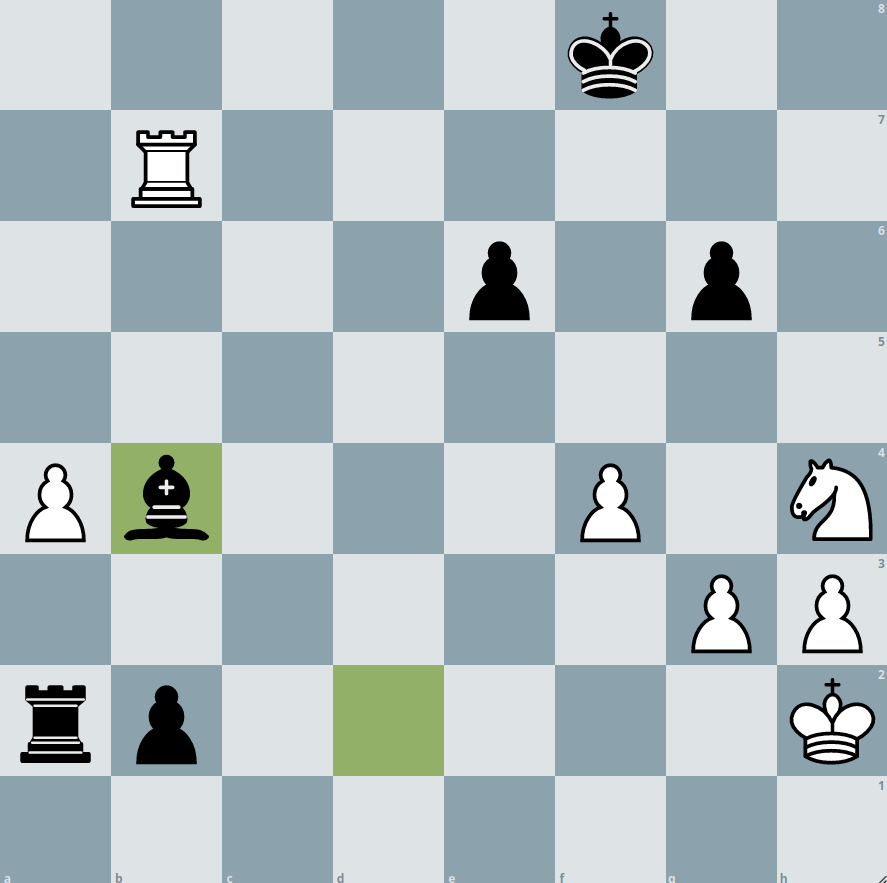
after 2. Kh1:

and after 2... b1=Q#
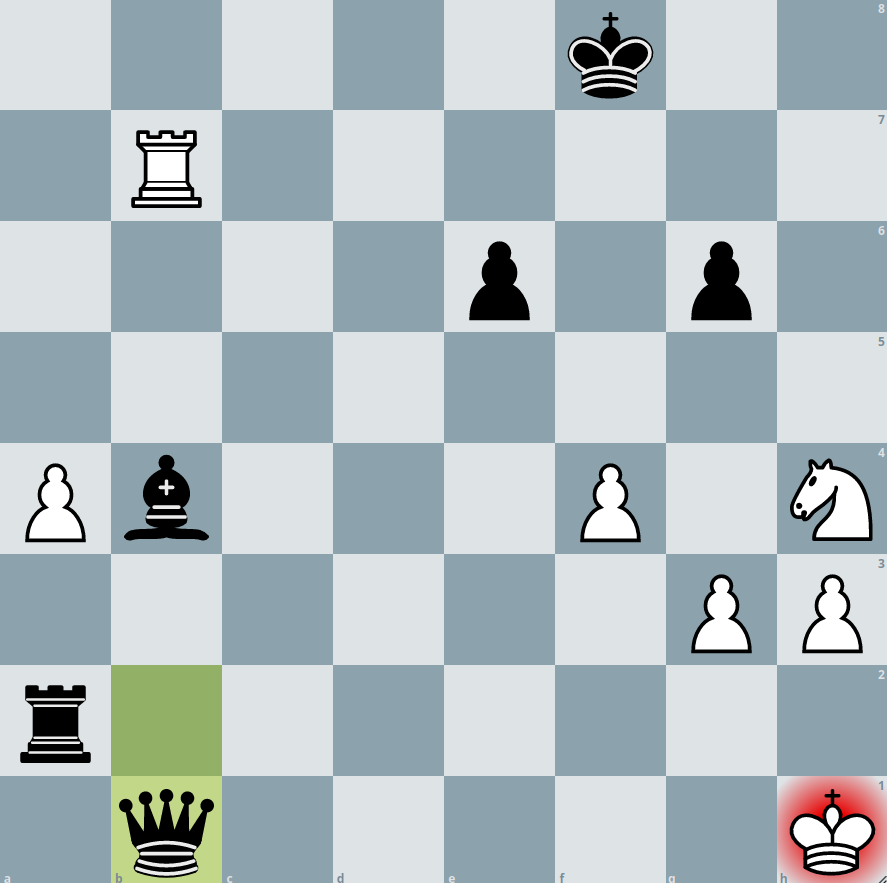
How are you proposing that 3. Rxb1 is going to happen?
My question was: what would happen if black did not move his bishop to b4, but rather took the pawn at f4. So far, the answers I keep getting begin with b4
after 1... Bxf4
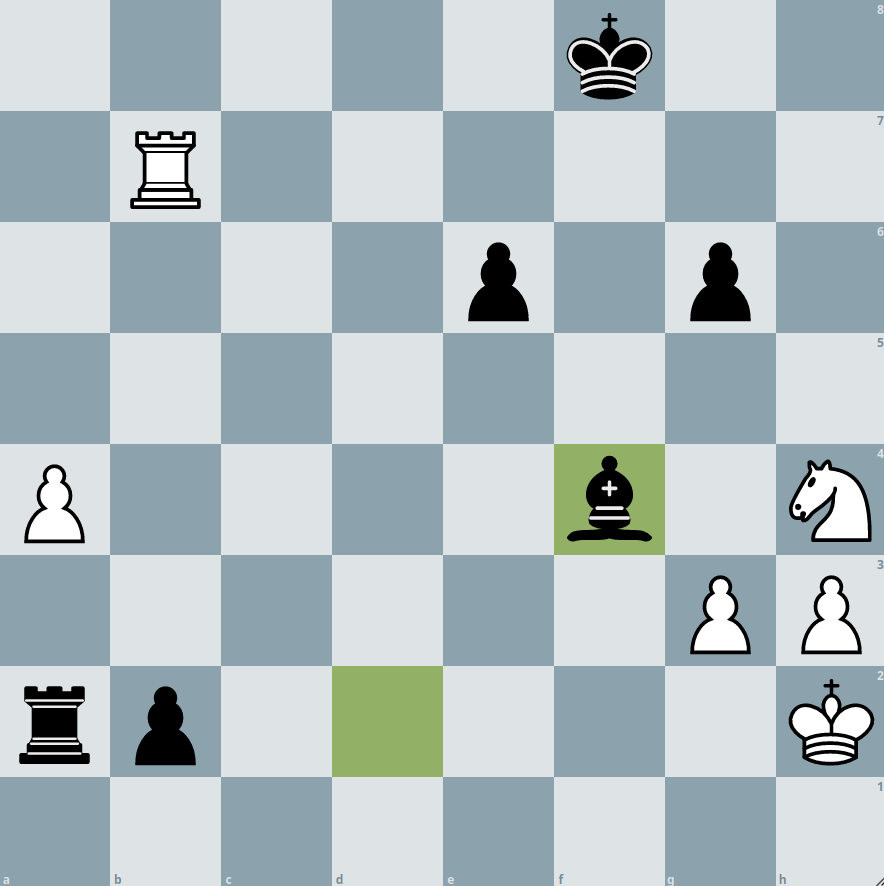
White can play either 2.Ng2, 2.Kh1 or 2.Kg1
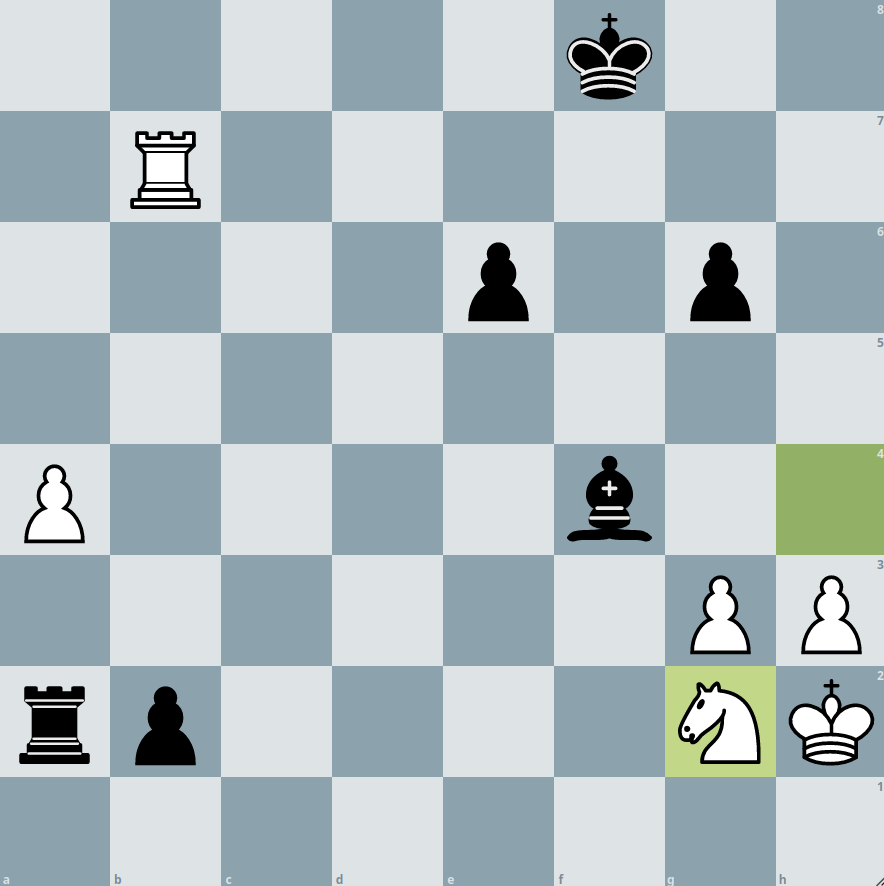
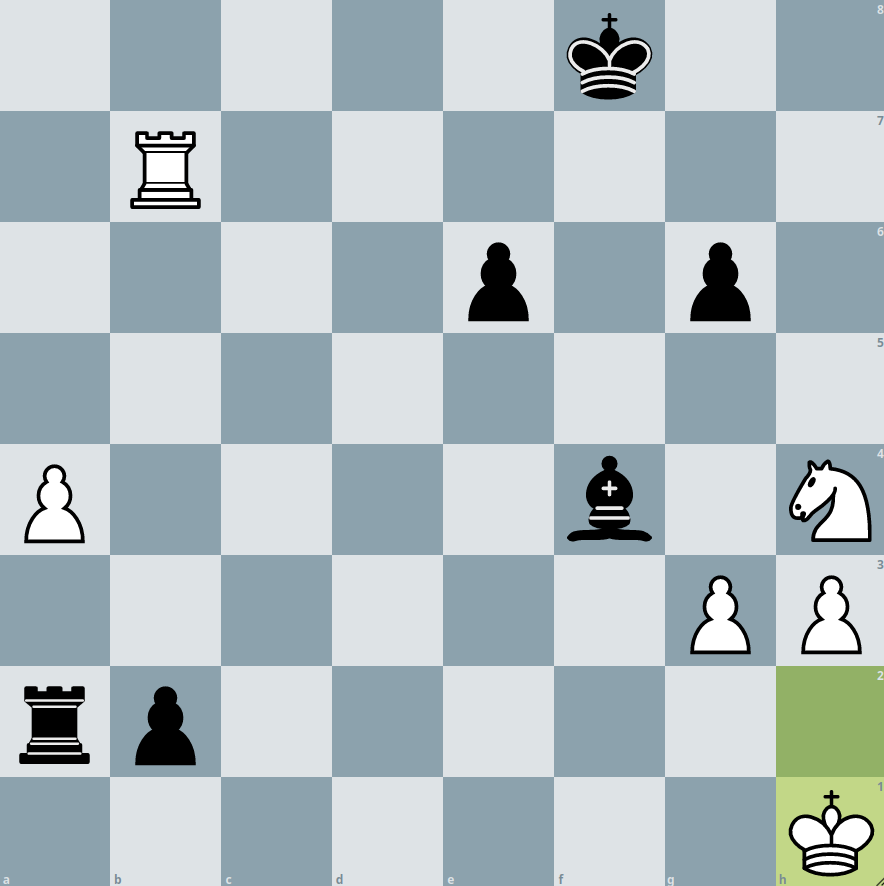
which in all cases stop the threat of 2... b1=Q because now 3. Rxb1 is available
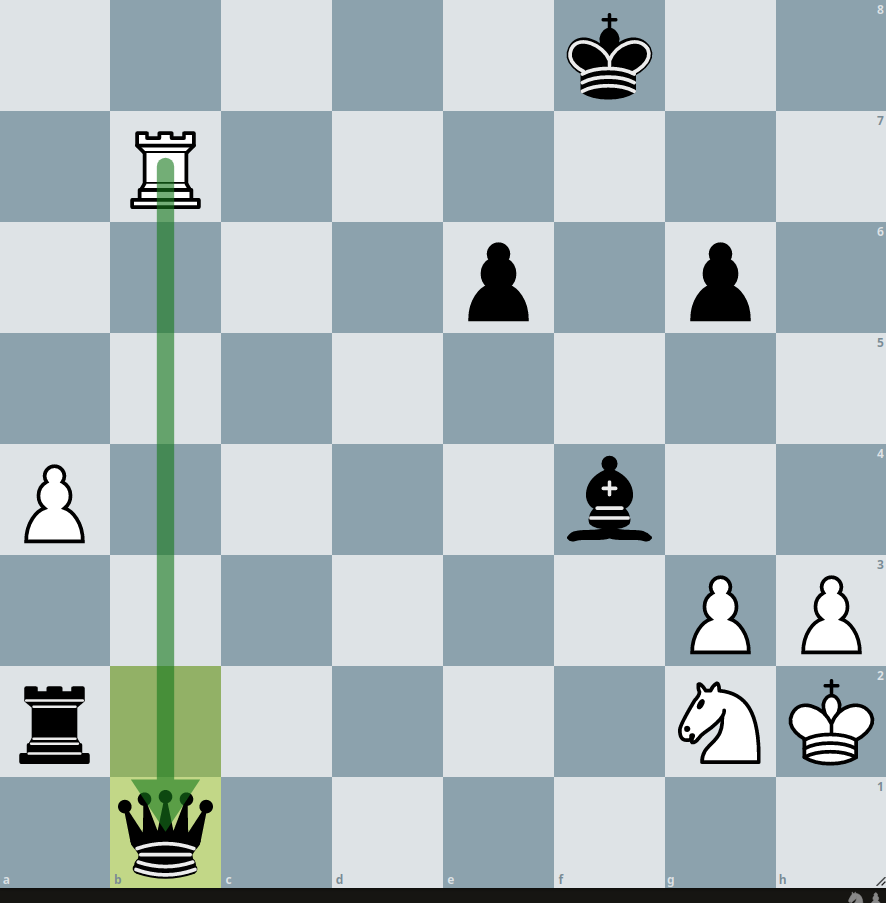
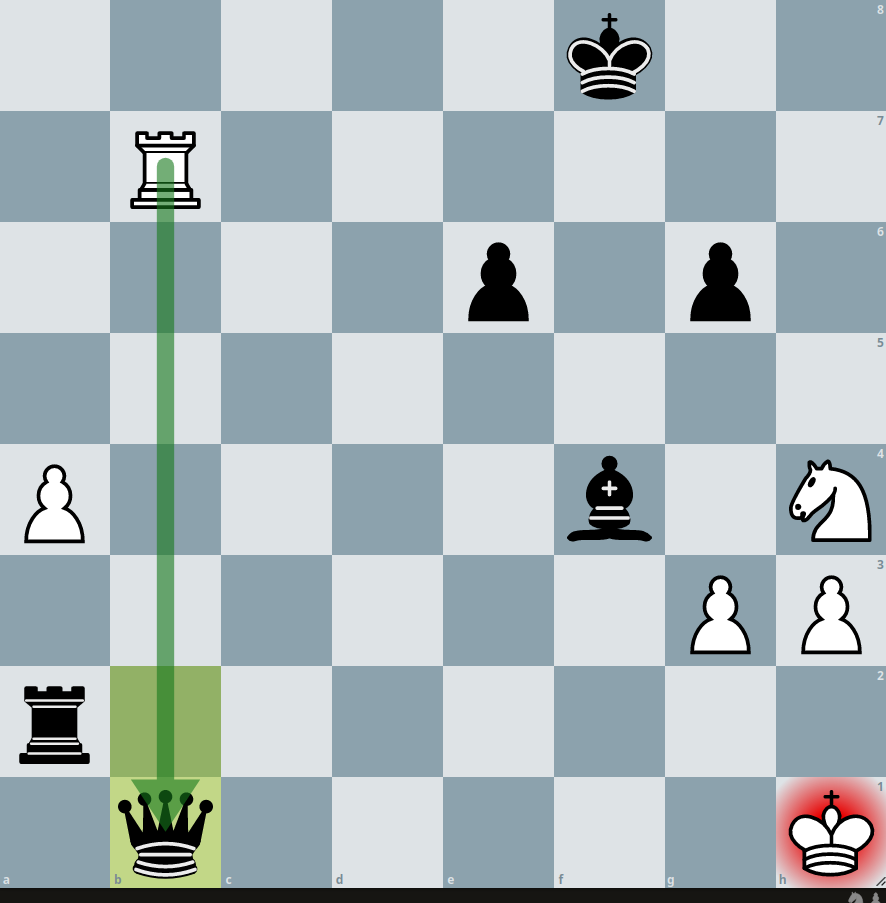
The move Bb4 has two functions: clearing the way for a possible discovered check in the second rank, and shielding the promotion square from white rook. On the other hand, the move Bxf4 only clears the way for the discovered check, but doesn't protect b1, so promotion is no longer possible.
Black could always move the rook to a1 before promoting the pawn. It forces a trade, but still leaves black with an advantage.
If white moves his knight to g2, check with the bishop at g3 also gets him another pawn and opens up the king's defenses a little.
White could also take the bishop at f4 with the pawn, but that would just lead to a discovered check.
Given, moving the bishop to b4 does give a better outcome if white moves the king back to row 1. Thanks for walking me through it!
Black could always move the rook to a1 before promoting the pawn. It forces a trade, but still leaves black with an advantage.
This is too slow. After 1... Bxf4 2. Ng2/Kh1/Kg1 Ra1, white can simply take the pawn for free with 3. Rxb2, and black loses all the advantage.
If white moves his knight to g2, check with the bishop at g3 also gets him another pawn and opens up the king’s defenses a little.
Trading a bishop for a pawn (one pawn that wasn't passed and only in the third rank) is not a very good deal, and black makes no progress towards promoting. Also, in endgames, king activity tends to be more important that king safety.
The bishop is in danger and unsupported no matter where you move it.
What I meant with giving check with the rook was:
1… Bxf4 2. Kh1/Kg1 Ra1+
That puts white in check with the rook, forcing the king to move, followed by b1Q. If then white takes the new queen at b1, she is protected by the rook at a1. Again, not the most elegant solution but at least black is not giving his promoted pawn away for nothing
Here's a more detailed explanation:
... Bxf4
(There are a couple things white could do here, including taking the pawn at g6+, but nothing that really puts white ahead, because black is eventually looking to promote the pawn for discovered check. White can't take the pawn with his rook before it's promoted because he loses the rook. He can't take the promoted pawn either because he needs to get out of check from the black rook. Uncovering the king by taking the bishop with his pawn would work to white's disadvantage against a rook-queen attack.)
Then white's only move would be:
Nf2
Then black could either take the white rook with the new queen or try to maneuver into mate with the rook and queen.
Is it b2b1?
Rook just takes the piece for free, don't think that's it.